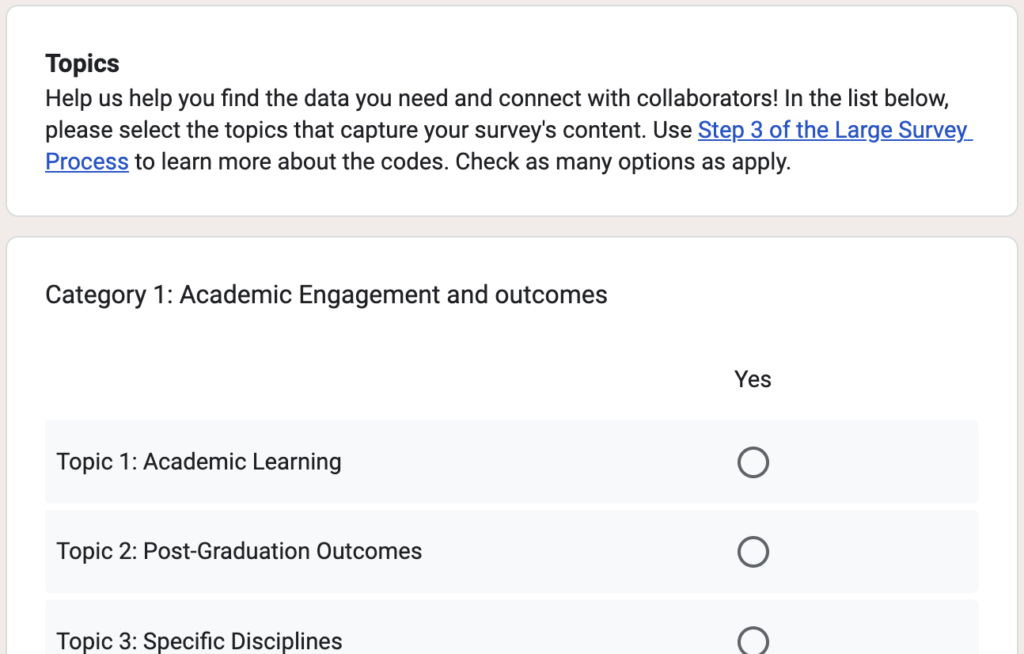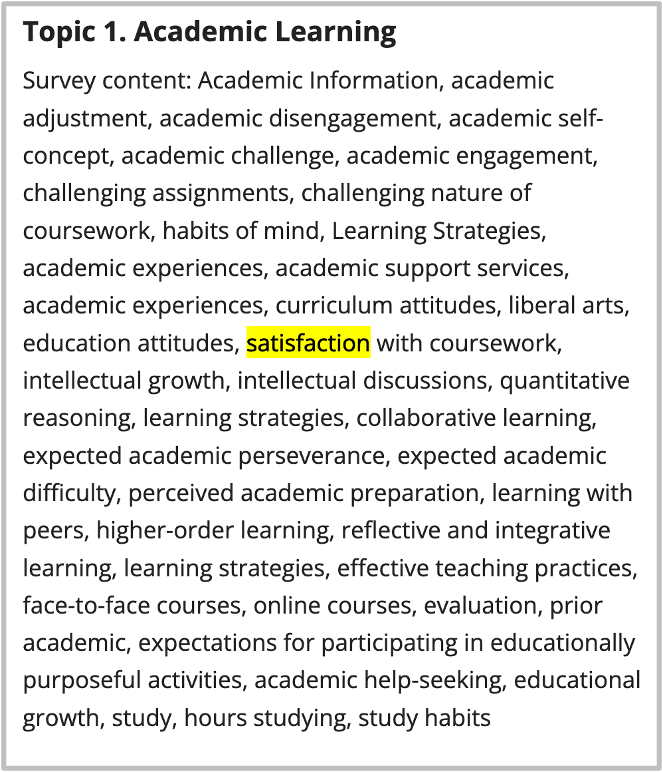Large Survey Process Step 3
Step 3. What topics will you cover?
As we mentioned in Step 2, we developed a set of categories and topics to assign to the large surveys. These topics will help future surveyors filter the Large Survey Dashboard to find existing survey data and identify other people doing similar surveys.
By adding topics to your survey, you help other people (including yourself!) find the data they need.
Why do we ask this question on the Large Survey Request Form?
Identifying our survey’s topics can help us share existing survey data, collaborate on future projects, and make things a little simpler for everyone (including our participants!).

Categories & topics overview
Further down this page, you’ll find twenty-one (21) topics that you can assign to your surveys and use to filter the Large Survey Dashboard. To make topics easier to find, we clustered these topics into five (5) categories.
Surveys can be assigned as many topics as needed.
How did we develop the categories and topics? We began by reviewing past large surveys from 2018 through early 2023. We used content from the Large Survey Request Form, technical documentation written by the survey authors, and the titles of the surveys. We entered this content into Chat GPT and asked it to generate 20 topics. We then removed, added, edited, and tested the topics over several months. Finally, we asked prior Large Survey researchers to test the topics and categories by applying them to surveys they previously conducted.
How do they work? The categories and topics are designed to tag the content in our large surveys. The categories and topics are not meant to create a conceptually ideal sorting of the surveys’ content, nor are they mutually exclusive. You may find that your search terms are associated with categories or topics that you don’t think are a good fit. That’s perfectly fine. As long as you can identify topics in the list below, you will be able to use them to filter the Large Survey Dashboard.
As long as you can find topics for your survey, you will be able to use them to filter the Large Survey Dashboard. (Even if you don’t think the topics and categories are a perfect fit.)
A note on demographics
The topics and categories do not include demographic items because these items exist in most of the large surveys. We considered the following to be demographics: race, ethnicity, gender, religion, socioeconomic status, sexual identity, housing, student work, student financial aid, military experience, and similar items.
COVID-specific surveys
We also excluded topics about the pandemic and COVID-19 because surveys with those topics were time-delimited and clearly named.
Finding topics that match your survey content or search interests
Ctrl/Cmd + F
The key to finding topics on this page is Ctrl/Cmd+F . While you are in this page, simultaneously push the Ctrl (or Cmd if you’re a Mac user) and F buttons on your keyboard and then enter the terms you’re looking for in the pop-up box. When you find your search terms, see what topic(s) they’re associated with. That topic (or topics) is what you will use to assign to your surveys in the Large Survey Request Form, or you can use them to filter the Large Survey Dashboard.
Example
Let’s say you are filling out the Large Survey Request form for a survey that include students’ satisfaction with their undergraduate experience. (Or using the Large Survey Dashboard to find surveys that include students’ satisfaction with their undergraduate experience.)
In this web page, you would simultaneously push the Ctrl (or Cmd)and F buttons on your keyboard, which would pop up a box in the upper-right of your screen that looks something like this (the appearance will depend on your browser and your device settings):

In that box, you would type satisfaction:

You could then click Enter or the up and down arrows to see which topics satisfaction shows up in:

We see that satisfaction is associated with lots of topics, including Topic 1. Academic Learning, Topic 2. Post-Graduation Outcomes, Topic 9. University Satisfaction, and several others.
In Topic 1. Academic Learning, satisfaction shows up as “satisfaction with coursework,” which isn’t exactly the concept we’re looking for.

Topic 2. Post-Graduation Outcomes is a similar mismatch, with satisfaction showing up as “job satisfaction.”

We find what we’re looking for in Topic 9. University Satisfaction, where we see the phrases “Overall satisfaction, college satisfaction.” You can add this topic to your Large Survey Request Form. (Or use it to filter the Large Survey Dashboard.)

If you’re struggling to identify topics that fit your survey, contact largesurvey@wfu.edu.
Categories and Topics
Tips for best practice
When it comes to assigning topics to your survey, more is better!
The more topics you add to your survey, the easier it will be for future Large Survey Dashboard users (that’s you!) to find surveys that match their needs.
Category 1: Academic Engagement and Outcomes
Topic 1. Academic Learning
Survey content: Academic Information, academic adjustment, academic disengagement, academic self-concept, academic challenge, academic engagement, challenging assignments, challenging nature of coursework, habits of mind, Learning Strategies, academic experiences, academic support services, academic experiences, curriculum attitudes, liberal arts, education attitudes, satisfaction with coursework, intellectual growth, intellectual discussions, quantitative reasoning, learning strategies, collaborative learning, expected academic perseverance, expected academic difficulty, perceived academic preparation, learning with peers, higher-order learning, reflective and integrative learning, learning strategies, effective teaching practices, face-to-face courses, online courses, evaluation, prior academic, expectations for participating in educationally purposeful activities, academic help-seeking, educational growth, study, hours studying, study habits, variety of courses, stimulating learning environment
Topic 2. Post-Graduation Outcomes
Survey content: post-graduation, post-graduation employment, continuing education, post-graduation volunteering, donations, job offers, job satisfaction, job acceptance, post-graduate activities, work plans, academic plans (e.g., graduate school)
Topic 3. Specific Disciplines
Survey content: Arts, visual arts, performing arts, arts experiences, arts involvement, science identity, science self-efficacy, school of business, business programs
Topic 4. Student-Faculty Interactions
Survey content: experiences with faculty, faculty mentorship, faculty contact and communication, interactions with faculty, faculty expectations, faculty Input, relationships with faculty, student-faculty interactions, faculty interactions, Faculty Fellows, Faculty Fellows familiarity, comfort having conversations with faculty members, teacher/student ratio
Category 2: Community, Climate, & Co-curriculars
Topic 5. Belonging & Community
Survey content: Perceptions of peers, social experiences, social self-concept, positive relationships, belonging, sense of belonging, loneliness, quality of interactions, faculty belonging, feel comfortable being myself, feel valued, feel like part of the community
Topic 6. Civic Engagement
Survey content: Civic awareness, civic engagement, community engagement, faculty community engagement, social agency, staff & faculty community partnership skills, volunteer service, service to community, civic growth, civic growth, community service, volunteer work
Topic 7. Co-Curricular Involvement
Survey content: extracurricular activities, campus activities, campus events, leadership, recreation, athletics, sports, participation in athletics, high school athletics, college athletics, interest in athletics, likelihood of college involvement, college activities, mentorship (faculty mentorship is in the student-faculty interactions category), college activities, activity engagement, co-curricular learning, student organizations, panhellenic, Greek life, sororities & fraternities, events, traditions
Topic 8. Diversity, Equity, Inclusion, and Accessibility
Survey content: campus climate, diversity and discrimination, diversity, equity, inclusion, accessibility, cross-racial interactions, pluralistic orientation, faculty equity, interactions with diversity, student disability accommodations, learning assistance, student disability accommodations awareness, expected discussions with diverse others, discussions with diverse others, support for gender equity
Topic 9. University Satisfaction
Survey content: Overall satisfaction, college satisfaction, college reputation orientation, campus attitudes
Topic 10. Sustainability
Survey content: Sustainability, climate change, environmental and social justice, environmental policy, food and agriculture, human health and the environment, transportation, waste,climate change, national security & global peace, planetary/ecological health, public health, and social justice/injustice,
Category 3: Faculty & Staff
Topic 11. Administration
Survey content: Risk, strategic risk, operational risk
Topic 12. Faculty & Staff Employment
Survey content: Faculty time use, professional support, faculty input, faculty equity, overall atmosphere, tenure attitudes, workload, research barriers, research productivity
Category 4: Health & Wellbeing
Topic 13. Mental Health
Survey content: positive mental health, anxiety & depression, body image, suicide, diagnosed mental iIllnesses, use of counseling and therapy, satisfaction with counseling and therapy, counseling – perceptions about, stigma, behavioral health medication, eating disorders, mood, happiness, anxiety, depression, social anxiety, self-esteem, coping skills, positive coping, help-seeking, counseling/therapy use and satisfaction, mental illness, mindfulness, self-injury
Topic 14. Physical Health
Survey content: Perceived health status, physical health, exercise, nutrition, physical activity, weight, eating habits, personal health, health services utilization, medications, medical providers, fitness, sleep, sleep patterns, medications, medical providers, hospital, emergency department, emergency room
Topic 15. Safety & Other Basic Needs
Survey content: safety, campus safety supports, perceptions of risk, campus police, police, community police, police interaction, police satisfaction, satisfaction with police, campus police attitudes, campus safety, personal safety, bystander behavior, bystander intervention, bystanding, upstanding, violence, interpersonal violence, injury and violence prevention, violence, interpersonal violence, basic security needs like food and housing, food security, financial health, incident reporting, relationship violence, sexual assault, sexual misconduct, safety features like lighting, safety phones, crime prevention through environmental design, escorts
Topic 16. Sexual Health & Behavior
Survey content: Sexual health, safe sex, safe sex education, social norms, barrier methods, condom distribution, condom use, STI, HIV, STI testing, HIV testing, STI and HIV prevention, pregnancy, types of sexual activities, oral, anal, vaginal
Topic 17. Substance Use
Survey content: Substance Use, Personal Alcohol Use, Personal Substance Use, Perception of Risk regarding Substance Use, Other Students’ Alcohol Use, Perceptions of Peer Substance Use, alcohol consumption, drinking habits, alcohol attitudes, alcohol activities, alcohol incidents, heavy drinking, impaired driving, tobacco use, drug, alcohol harm reduction, drug harm reduction, substance use harm reduction, cannabis, BASICS, Recovery, Blackout, Liquor, Beer, Wine, Seltzer, Medical amnesty, Fake ID, Drinking games, BAC, blood alcohol, standard drink, BORG, marijuana
Topic 18. Wellbeing
Survey content: Wellbeing, well-being, subjective wellbeing, wellness, meaning, sense of meaning, purpose, life goals, personal growth, flourishing, resilience, contribution, life satisfaction, optimism, perseverance, goals in life
Category 5: University Infrastructure
Topic 19. Campus Resources
Survey content: campus resources, knowledge of campus services, campus services – knowledge and perceptions, satisfaction with campus services, residential life, transportation, transportation barriers, housing, supportive campus environment, importance of campus environment, campus environment, supportive environment, support services, library, libraries
Topic 20. Policy & Leadership
Survey content: Students’ perceptions of leadership and policies,
Topic 21. Technology
Survey content: technology, devices, information technology, learning management systems, Canvas
Questions? Contact us at largesurvey@wfu.edu
